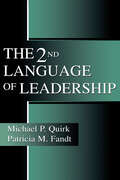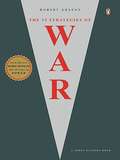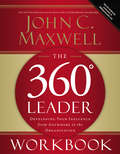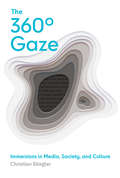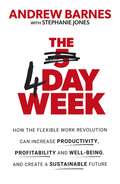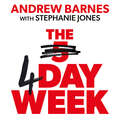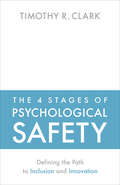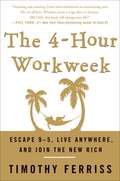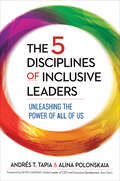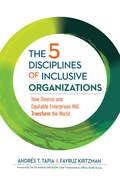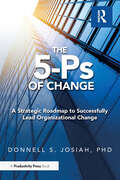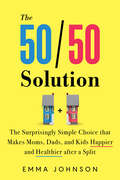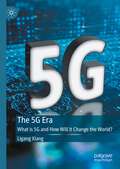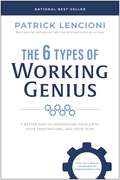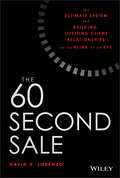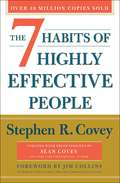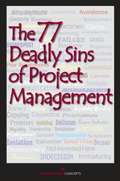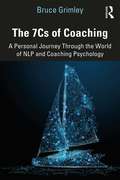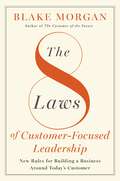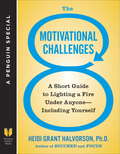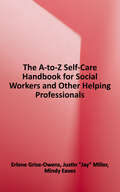- Table View
- List View
The 2nd Language of Leadership
by Michael P. Quirk Patricia M. FandtThis book focuses on the behavioral and personality areas that can be used to strengthen one's skills and to make wise decisions about when and how to lead. It was written for the working professional who wants to learn what he or she can do by working with their personality to become more satisfied with and masterful in their leadership roles. Good leaders have learned to succeed over time by acquiring the needed range of personal skills, much like one learns a second language. Geared for entry and mid-term leaders, this book is an empirically based training guide to acquire knowledge and implement a plan to help increase one's leadership skills. Within the framework of 10 chapters, this book: * promotes a shared recognition of the role that personality plays in leadership by reviewing a case study of representative leadership situation that both identifies familiar personal struggles and organizational changes; * offers a way of thinking about how personality in general and the Big 5 in particular fills in the gaps and connects the pieces when it comes to how people become effective leaders; * illustrates how--within the Big 5 framework--to use the 2nd language approach to leverage natural personality strengths and manage weaknesses in an effort to build greater leadership effectiveness; * makes available 2nd language tools including effective intervention strategies and goal setting techniques based on enabling philosophies to understand what makes this approach accessible and practical to use; and * reassures that most leadership failures are reversible and that through using the 2nd language approach, these inevitable and sometimes necessary setbacks afford clarity about how to use your style to the best advantage.
The 33 Strategies of War
by Joost Elffers Robert GreeneBrilliant distillations of the strategies of war--and the subtle social game of everyday life--by the bestselling author of The 48 Laws of Power and MasteryRobert Greene's groundbreaking guides, The 48 Laws of Power, The Art of Seduction, and his latest book, Mastery, espouse profound, timeless lessons from the events of history to help readers vanquish an enemy, ensnare an unsuspecting victim, or become the greatest in your field. In The 33 Strategies of War, Greene has crafted an important addition to this ruthless and unique series.Spanning world civilizations, synthesizing dozens of political, philosophical, and religious texts and thousands of years of violent conflict, The 33 Strategies of War is a comprehensive guide to the subtle social game of everyday life informed by the most ingenious and effective military principles in war. Structured in Greene's trademark style, The 33 Strategies of War is the I-Ching of conflict, the contemporary companion to Sun Tzu's The Art of War.Abundantly illustrated with examples from history, including the folly and genius of everyone from Napoleon to Margaret Thatcher, Shaka the Zulu to Lord Nelson, Hannibal to Ulysses S. Grant, as well as movie moguls, Samurai swordsmen, and diplomats, each of the thirty-three chapters outlines a strategy that will help you win life's wars. Learn the offensive strategies that require you to maintain the initiative and negotiate from a position of strength, or the defensive strategies designed to help you respond to dangerous situations and avoid unwinnable wars. The great warriors of battlefields and drawing rooms alike demonstrate prudence, agility, balance, and calm, and a keen understanding that the rational, resourceful, and intuitive always defeat the panicked, the uncreative, and the stupid. An indispensable book, The 33 Strategies of War provides all the psychological ammunition you need to overcome patterns of failure and forever gain the upper hand.
The 360 Degree Leader Workbook: Developing Your Influence from Anywhere in the Organization
by John C. MaxwellThe 360 Degree Leader Workbook will equip you with the skills you need to begin making a difference in your organization, career, and life, today—with or without the promotion.Ninety-nine percent of all leadership occurs not from the top but from the middle of an organization. Usually, an organization has only one person who is the leader. So what do you do if you are not that one person?In The 360 Degree Leader Workbook, Maxwell addresses that very question and takes the discussion even further. You don't have to be the main leader to make a significant impact in your organization. Good leaders are not only capable of leading their followers but are also adept at leading their superiors and their peers.Debunking myths and shedding light on the challenges, John Maxwell offers specific principles for Leading Down, Leading Up, and Leading Across. 360-Degree Leaders can lead effectively, regardless of their position in an organization. By applying Maxwell's principles from this workbook and accompanying book, you will expand your influence and ultimately be a more valuable team member.
The 360° Gaze: Immersions in Media, Society, and Culture
by Christian StieglerA comprehensive study of the pervasive role of immersion and immersive media in postmodern culture, from a humanities and social sciences perspective.Virtual reality, augmented reality, mixed reality, and other modes of digitally induced immersion herald a major cultural and economic shift in society. Most academic discussions of immersion and immersive media have focused on the technological aspects. In The 360° Gaze, Christian Stiegler takes a humanities and social science approach, emphasizing the human implications of immersive media in postmodern culture. Examining characteristics common to all immersive experiences, he uncovers dominant metaphors, such as the rabbit hole, and prevailing ideologies. He raises fundamental questions about opportunities and risks associated with immersion, as well as the potential effects on individuals, communities, and societies.
The 4 Day Week: How the Flexible Work Revolution Can Increase Productivity, Profitability and Well-being, and Create a Sustainable Future
by Andrew BarnesSHORTLISTED FOR THE BUSINESS BOOK AWARDS 2021In The 4 Day Week, entrepreneur and business innovator Andrew Barnes makes the case for the four-day week as the answer to many of the ills of the 21st-century global economy. Barnes conducted an experiment in his own business, the New Zealand trust company Perpetual Guardian, and asked his staff to design a four-day week that would permit them to meet their existing productivity requirements on the same salary but with a 20% cut in work hours. The outcomes of this trial, which no business leader had previously attempted on these terms, were stunning. People were happier and healthier, more engaged in their personal lives, and more focused and productive in the office. The world of work has seen a dramatic shift in recent times: the former security and benefits associated with permanent employment are being displaced by the less stable gig economy. Barnes explains the dangers of a focus on flexibility at the expense of hard-won worker protections, and argues that with the four-day week, we can have the best of all worlds: optimal productivity, work-life balance, worker benefits and, at long last, a solution to pervasive economic inequities such as the gender pay gap and lack of diversity in business and governance. The 4 Day Week is a practical, how-to guide for business leaders and employees alike that is applicable to nearly every industry. Using qualitative and quantitative data from research gathered through the Perpetual Guardian trial and other sources by the University of Auckland and Auckland University of Technology, the book presents a step-by-step approach to preparing businesses for productivity-focused flexibility, from the necessary cultural conditions to the often complex legislative considerations. The story of Perpetual Guardian's unprecedented work experiment has made headlines around the world and stormed social media, reaching a global audience in more than seventy countries. A mix of trenchant analysis, personal observation and actionable advice, The 4 Day Week is an essential guide for leaders and workers seeking to make a change for the better in their work world.
The 4 Day Week: How the Flexible Work Revolution Can Increase Productivity, Profitability and Well-being, and Create a Sustainable Future
by Andrew BarnesSHORTLISTED FOR THE BUSINESS BOOK AWARDS 2021In The 4 Day Week, entrepreneur and business innovator Andrew Barnes makes the case for the four-day week as the answer to many of the ills of the 21st-century global economy. Barnes conducted an experiment in his own business, the New Zealand trust company Perpetual Guardian, and asked his staff to design a four-day week that would permit them to meet their existing productivity requirements on the same salary but with a 20% cut in work hours. The outcomes of this trial, which no business leader had previously attempted on these terms, were stunning. People were happier and healthier, more engaged in their personal lives, and more focused and productive in the office. The world of work has seen a dramatic shift in recent times: the former security and benefits associated with permanent employment are being displaced by the less stable gig economy. Barnes explains the dangers of a focus on flexibility at the expense of hard-won worker protections, and argues that with the four-day week, we can have the best of all worlds: optimal productivity, work-life balance, worker benefits and, at long last, a solution to pervasive economic inequities such as the gender pay gap and lack of diversity in business and governance. The 4 Day Week is a practical, how-to guide for business leaders and employees alike that is applicable to nearly every industry. Using qualitative and quantitative data from research gathered through the Perpetual Guardian trial and other sources by the University of Auckland and Auckland University of Technology, the book presents a step-by-step approach to preparing businesses for productivity-focused flexibility, from the necessary cultural conditions to the often complex legislative considerations. The story of Perpetual Guardian's unprecedented work experiment has made headlines around the world and stormed social media, reaching a global audience in more than seventy countries. A mix of trenchant analysis, personal observation and actionable advice, The 4 Day Week is an essential guide for leaders and workers seeking to make a change for the better in their work world.
The 4 Day Week: How the Flexible Work Revolution Can Increase Productivity, Profitability and Well-being, and Create a Sustainable Future
by Andrew BarnesSHORTLISTED FOR THE BUSINESS BOOK AWARDS 2021In The 4 Day Week, entrepreneur and business innovator Andrew Barnes makes the case for the four-day work week as the answer to many of the ills of the 21st-century global economy. Barnes conducted an experiment in his own business, the New Zealand trust company Perpetual Guardian, and asked his staff to design a four-day week that would permit them to meet their existing productivity requirements on the same salary but with a 20% cut in work hours. The outcomes of this trial, which no business leader had previously attempted on these terms, were stunning. People were happier and healthier, more engaged in their personal lives, and more focused and productive in the office. The world of work has seen a dramatic shift in recent times: the former security and benefits associated with permanent employment are being displaced by the less stable gig economy. Barnes explains the dangers of a focus on flexibility at the expense of hard-won worker protections, and argues that with the four-day week, we can have the best of all worlds: optimal productivity, work-life balance, worker benefits and, at long last, a solution to pervasive economic inequities such as the gender pay gap and lack of diversity in business and governance. The 4 Day Week is a practical, how-to guide for business leaders and employees alike that is applicable to nearly every industry. Using qualitative and quantitative data from research gathered through the Perpetual Guardian trial and other sources by the University of Auckland and Auckland University of Technology, the book presents a step-by-step approach to preparing businesses for productivity-focused flexibility, from the necessary cultural conditions to the often complex legislative considerations. The story of Perpetual Guardian's unprecedented work experiment has made headlines around the world and stormed social media, reaching a global audience in more than seventy countries. A mix of trenchant analysis, personal observation and actionable advice, The 4 Day Week is an essential guide for leaders and workers seeking to make a change for the better in their work world.
The 4 Stages of Psychological Safety: Defining the Path to Inclusion and Innovation
by Timothy R. ClarkThis book is the first practical, hands-on guide that shows how leaders can build psychological safety in their organizations, creating an environment where employees feel included, fully engaged, and encouraged to contribute their best efforts and ideas.Fear has a profoundly negative impact on engagement, learning efficacy, productivity, and innovation, but until now there has been a lack of practical information on how to make employees feel safe about speaking up and contributing. Timothy Clark, a social scientist and an organizational consultant, provides a framework to move people through successive stages of psychological safety. The first stage is member safety-the team accepts you and grants you shared identity. Learner safety, the second stage, indicates that you feel safe to ask questions, experiment, and even make mistakes. Next is the third stage of contributor safety, where you feel comfortable participating as an active and full-fledged member of the team. Finally, the fourth stage of challenger safety allows you to take on the status quo without repercussion, reprisal, or the risk of tarnishing your personal standing and reputation. This is a blueprint for how any leader can build positive, supportive, and encouraging cultures in any setting.
The 4-Hour Workweek: Escape 9-5, Live Anywhere, and Join the New Rich
by Timothy FerrissWhat do you do? Tim Ferriss has trouble answering the question. Depending on when you ask this controversial Princeton University guest lecturer, he might answer: I race motorcycles in Europe; I ski in the Andes; I scuba dive in Panama; I dance tango in Buenos Aires. He has spent more than five years learning the secrets of the New Rich, a fast-growing subculture who has abandoned the deferred-life plan; and instead mastered the new currencies: time and mobility to create luxury lifestyles in the here and now. Whether you are an overworked employee or an entrepreneur trapped in your own business, this book is the compass for a new and revolutionary world. Join Tim Ferriss as he teaches you: How to outsource your life to overseas virtual assistants for $5 per hour and do whatever you want; How blue-chip escape artists travel the world without quitting their jobs; How to eliminate 50% of your work in 48 hours using the principles of a forgotten Italian economist; How to trade a long-haul career for short work bursts and freuent "mini-retirements"; What the crucial difference is between absolute and relative income; How to train your boss to value performance over presence, or kill your job (or company) if it's beyond repair; What automated cash-flow muses are and how to create one in 2 to 4 weeks; How to cultivate selective ignorance and create time with a low-information diet; What the management secrets of Remote Control CEOs are; How to get free housing worldwide and airfare at 50- 80% off; How to fill the void and create a meaningful life after removing work and the office. You can have it all really.
The 4G Mobile Revolution: Creation, Innovation and Transformation at EE
by Stuart Jackson Olaf SwanteeThe 4G Mobile Revolution charts the extraordinary journey of innovation and change at EE, told by its former CEO, Olaf Swantee. This is the story of the highly successful transformation when Orange and T-Mobile merged to form a whole new organization, a whole new brand and a whole new mobile era with the introduction of the 4G network. This authoritative exploration of the telecommunications industry takes the reader through every crucial stage in EE's journey: from the crafting of the secret merger, to designing a visionary new brand identity and innovating at speed to provide superfast 4G. Change initiatives are notoriously difficult to navigate and very rarely are considered to be a success. However, transformation is omnipresent and inherent to business success in today's fast-moving climate. This book charts the ups and downs of change and pulls out insightful key principles for navigating the storm of transformation in any industry. Successful business revolution requires inspirational leadership, a motivating purpose for your people, a keen sense of brand identity, a culture of innovation, a willingness to break the status quo and a truly collaborative team. Olaf Swantee and Stuart Jackson explore these crucial and exciting themes as they recount EE's journey from merger, to 4G innovation, to the company's takeover by BT for an estimated value of 12.5 billion pounds. This is an inside look into the practices of one of today's most inspirational leaders and is essential reading for any executive grappling with change.
The 5 Disciplines of Inclusive Leaders: Unleashing the Power of All of Us
by Alina Polonskaia Andrés T. TapiaDiversity initiatives are falling short. This book shows leaders how to develop the skills needed to build sustainably inclusive organizations using a tested, research-based model developed by the global organizational consulting firm Korn Ferry. According to the journal Human Resource Management, companies are spending over $8 billion a year on diversity programs. Yet today, the senior leadership teams at Fortune 500 companies are far from mirroring the diversity of its workforce and its customers. Andrés Tapia and Alina Polonskaia, senior leaders at Korn Ferry, argue that to build sustainable diversity and inclusion, organizations need to have inclusive leaders at all levels.In this book, Tapia and Polonskaia draw on Korn Ferry's massive database of 3 million leadership assessments to reveal the essential qualities of inclusive leaders. They discuss the personality traits these leaders share and detail how to develop what they call the five disciplines of inclusive leadership: building interpersonal trust, integrating diverse perspectives, optimizing talent, applying an adaptive mindset, and achieving transformation. Tapia and Polonskaia also outline the competencies behind each discipline, describe individual and organizational exemplars of inclusive leadership, and show how the five disciplines enable leaders to unleash the power of all people and to build both structurally and behaviorally inclusive organizations. This book will help leaders foster the skills to deal with today's complex challenges and create a more inclusive, sustainable, and prosperous future for all of us.
The 5 Disciplines of Inclusive Organizations: How Diverse and Equitable Enterprises Will Transform the World (The Five Inclusive Disciplines Series)
by Andrés T. Tapia Fayruz KirtzmanA comprehensive new model for creating inclusive organizations, illuminating the vital role that inclusion plays in developing solutions to the critical social, environmental, and leadership challenges we face. Most organizational DE&I efforts are focused on changing individual behaviors. But unless you change the organizational structures-the practices, processes, and systems that surround and support individual behaviors-your change efforts will not take root. Structural inclusion makes behavioral inclusion stick. Andrs Tapia and Fayruz Kirtzman have found that five disciplines encompass the structures, mindsets, behaviors, and accountabilities required for creating inclusive organizations that will have transformational impact not only on their culture and people but also on society and the planet:1: Manage the Risk: know how to deal with the legal, reputational, and cultural risks of either doing the wrong thing, or not doing the right thing.2: Explode the Awareness: make sure leaders and employees are deeply informed about, and publicly committed to, the value of DE&I.3: Maximize the Talent Systems: ensure that leaders and managers display inclusive behaviors when they manage and optimize talent.4: Master the Logistics: integrate DE&I into operations in ways that lead to improved efficiencies. 5: See the Marketplace: expand to new consumer market segments, enhance cross culturally competent customer service, and form effective partnerships with overlooked communities.The authors provide assessment tools and case studies of organizations that have implemented each discipline, highlighting what worked and what tripped them up. And they take a wider view, showing how inclusive organizations practicing the five disciplines can address what they call society's four vital tasks: diversify leadership, eradicate polarization, achieve justice, and save the planet. This is a complete guide to how to make your organization a systematic, process-oriented engineer of change for the full range of your stakeholders.
The 5 Disciplines of Inclusive Teams: Unlocking Collective Power to Achieve Breakthrough (The Five Inclusive Disciplines Series)
by Andrés T. Tapia Michel A. BuffetThe final guide in the acclaimed Five Inclusive Disciplines trilogy introduces an actionable 5-step framework for building truly equitable, high-performing teams and unlocking their collective power to deliver groundbreaking results. In today’s fast-paced, interconnected world, breakthroughs don’t come from individuals—they come from teams. And not just any teams, but diverse and inclusive ones. With decades of experience and cutting-edge research, Andrés Tapia and Michel Buffet provide a revolutionary model that empowers teams to harness the full potential of diverse perspectives. At the heart of the book are The 5 Disciplines, which guide teams to tap into their collective power:Connecting – to build affiliationCaring – to nurture psychological safetySynchronizing – to harness collective intelligenceCultural Dexterity – to integrate diverse perspectivesPowersharing – to ensure equitable contributions The result? Unparalleled creativity, engagement, and performance. Through insightful guidance, practical tools, and a proven framework, The 5 Disciplines of Inclusive Teams shows how teams can unlock their collective power to achieve breakthrough results, transforming not only their organizations but also the future.
The 5-Ps of Change: A Strategic Roadmap to Successfully Lead Organizational Change
by Donnell JosiahNeed a proven roadmap for change success?The 5-Ps Of Change: A Strategic Roadmap to Successfully Lead Organizational Change by Donnell S. Josiah, PhD, PMP, SA, is an authoritative guide for business leaders and professionals seeking to transform their organizations with precision and purpose. Drawing on over 25 years of hands-on experience across Federal, State, and commercial sectors, Josiah demystifies the art of organizational change management through the lens of five critical pillars: Purpose, Planning, Process, Performance, and People.Packed with practical insights and a wealth of tried-and-tested strategies, this book equips executives, business leaders, and change practitioners with the tools needed to implement transformative initiatives that stick. From crafting clear purpose statements that inspire, to building resilient plans, and optimizing performance metrics, Josiah’s roadmap is comprehensive yet accessible. The 5-Ps of Change not only addresses the structural and strategic aspects of change but also emphasizes the human elements, ensuring that change efforts successfully engage and uplift the workforce it is intended to impact.Whether you’re leading a major IT development project or embarking on a large-scale organizational transformation, The 5-Ps Of Change serves as your guide to making a lasting impact. With a balance of strategic wisdom and practical application, this book is a must-have resource for mastering the complexities of today’s dynamic organizational landscape.Get the tools you need—start leading change today!
The 50/50 Solution: The Surprisingly Simple Choice that Makes Moms, Dads, and Kids Happier and Healthier after a Split
by Emma JohnsonThere is one proven method for happier kids, more involved dads, and less stressed-out moms after divorce—50/50 custodyIt's hard for everyone when parents split up—but the end of living together doesn't need to mean the end of a functional family. Part of the reason divorces are so traumatic for the kids involved is because of our child custody system, which truly sets everyone up for failure. Throughout the country, the default arrangement is for Mom to get majority time with the kids (and most of the responsibility of caring for them), for Dad to become an occasional visitor (and perhaps saddled with massive child support payments), and for the kids to lose the stability, structure and confidence of knowing they have two equally committed, loving parents. But it doesn't have to be this way!In The 50/50 Solution, creator of the Wealthy Single Mommy community Emma Johnson showcases the robust research proving that, in the vast majority of cases, equal timesharing is the best outcome for everyone in a family where the adults no longer live together. The 50/50 Solution will show you that equal parenting time leads to:Better physical, emotional, and mental health for children of divorceHigher career earnings for single mothersFathers who are more engaged and whose rights as parents are preservedFar less parental and legal conflictA progressive, forward-thinking cultural norm that promotes gender and racial equality for all families, regardless of their configurationA few states have already adopted 50/50 custody as the default arrangement, and several more are poised to follow. Equal parenting time is the custody framework of the future, and The 50/50 Solution shows readers how it helps our families and communities thrive.
The 5G Era: What is 5G and How Will it Change the World?
by Ligang XiangThis book states that the seventh information revolution is the intelligent Internet, and 5G is the foundation of the seventh information revolution. This book gives a clear introduction to the three major scenarios, six characteristics, core technologies, and global landscape of 5G, and answers "What is true 5G?" This book also gives an in-depth explanation of 5G-enabled traditional industries, and outlines the profound changes that 5G will bring to transportation, medical, industry, and agriculture. Finally, the author made bold assumptions about the opportunities and challenges that human society faces in the post-5G era. For readers who want to fully understand 5G, this book provides an important reference and is a must-have book.
The 6 Types of Working Genius: A Better Way to Understand Your Gifts, Your Frustrations, and Your Team
by Patrick M. LencioniNew York Times best-selling author Patrick Lencioni unveils a truly groundbreaking new model that will change the way we think about work and teams forever. The 6 Types of Working Genius is the fastest way to help people identify the type of work that brings them joy and energy, and avoid work that leads to frustration and burnout. Beyond the personal discovery and instant relief that Working Genius provides, the model also gives teams a remarkably simple and practical framework for tapping into one another&’s natural gifts, which increases productivity and reduces unnecessary judgment. In classic Lencioni fashion, Pat brings his model to life in a page-turning fable that is as relatable as it is compelling. He tells the story of Bull Brooks, an entrepreneur, husband, and father who sets out to solve his own frustration at work and stumbles into a new way of thinking that changes the way he sees his work, his team, and even his marriage. What sets this book—and the model behind it—apart from other tools and assessments is the speed at which it can be understood and applied, and the relevance it has to every kind of work in life, from running a company to launching a product to managing a family. In addition to this book, Lencioni and the Table Group have created a 10-minute assessment that helps individuals quickly identify their gifts and apply this model to themselves and their teams. Join the hundreds of thousands of people who have already discovered their Working Genius, and experience the transformation in your work, your team, and your life. Learn more about the Working Genius at WorkingGenius.com.
The 60 Second Sale: The Ultimate System for Building Lifelong Client Relationships in the Blink of an Eye
by David V. LorenzoEvery sale is made or lost in 60 seconds—make them count Cold calling and pushing your way into an office or a living room creates an atmosphere of adversity and distrust you must overcome before you close the deal. With those tired tactics, you’re swimming upstream, against a strong current, with a bag of rocks tied to your waist. Sales has changed. Legacy sales gimmicks destroy relationships right from the first minute. The 60 Second Sale is a turnkey system for building profitable, lifelong relationships. Whether you work with affluent consumers or sell to senior executives in FORTUNE 500 companies, this step-by-step guide will help you open doors, close deals, and make more money in a way that leverages your natural strengths. That’s the magnificence of the 60 second sale system. You get to be yourself and build your business. In this book you will discover: How to start a sales conversation in 60 seconds Who to target for immediate income A powerful yet easy-to-use system to generate relationship revenue Five ways to initiate new relationships What to say to make sure your business meetings result in money in the bank The secret to getting a “yes” every time, even in the most competitive sales environment The winning mindset that removes the stress, uncertainty, and fear from income generation And so many other effective business growth strategies, your competition won’t know what hit them Business relationships are built one minute at a time. From introduction to closing, every 60 seconds you have an opportunity to strengthen your relationship or destroy it. Isn’t it time you started leveraging your expertise, demonstrating your value, and building trust with your clients? When you do, they buy into who you are and how you can help them – right from the first minute. The 60 Second Sale is a fail-proof system for succeeding in today’s relationship-focused sales environment.
The 7 Habits of Highly Effective Families
by Stephen R. Covey Sandra Merrill CoveyIn his first major work since The 7 Habits of Highly Effective People, Steven R. Covey presents a practical and philosophical guide to solving the problems--large and small, mundane and extraordinary--that confront all families and strong communities. By offering revealing anecdotes about ordinary people as well as helpful suggestions about changing everyday behavior, The 7 Habits of Highly Effective Families shows how and why to have family meetings, the importance of keeping promises, how to balance individual and family needs, and how to move from dependence to interdependence. The 7 Habits of Highly Effective Families is an invaluable guidebook to the welfare of families everywhere.
The 7 Habits of Highly Effective People: 30th Anniversary Edition (The Covey Habits Series)
by Stephen R. Covey*New York Times bestseller—over 40 million copies sold* *The #1 Most Influential Business Book of the Twentieth Century* One of the most inspiring and impactful books ever written, The 7 Habits of Highly Effective People has captivated readers for nearly three decades. It has transformed the lives of presidents and CEOs, educators and parents—millions of people of all ages and occupations. Now, this 30th anniversary edition of the timeless classic commemorates the wisdom of the 7 Habits with modern additions from Sean Covey. The 7 Habits have become famous and are integrated into everyday thinking by millions and millions of people. Why? Because they work! With Sean Covey&’s added takeaways on how the habits can be used in our modern age, the wisdom of the 7 Habits will be refreshed for a new generation of leaders. They include: Habit 1: Be Proactive Habit 2: Begin with the End in Mind Habit 3: Put First Things First Habit 4: Think Win/Win Habit 5: Seek First to Understand, Then to Be Understood Habit 6: Synergize Habit 7: Sharpen the Saw This beloved classic presents a principle-centered approach for solving both personal and professional problems. With penetrating insights and practical anecdotes, Stephen R. Covey reveals a step-by-step pathway for living with fairness, integrity, honesty, and human dignity—principles that give us the security to adapt to change and the wisdom and power to take advantage of the opportunities that change creates.
The 77 Deadly Sins of Project Management
by Management Concepts PressCombat the Deadly Sins of Project Management!Project management is a tough business. Not only must project managers contend with schedules, budgets, and a host of stakeholder demands, but they must also deal with sometimes vexing human behaviors, such as whining, indecision, opposition, inflexibility, complacency, and tunnel vision, to name a few. Projects can be negatively impacted by common "sins" that hinder, stall, or throw the project off track.In The 77 Deadly Sins of Project Management, the contributors focus on each "deadly sin" and probe its manifestations and consequences for projects. By sharing their personal experiences, as well as some historical events, the contributors spotlight the effects and costs — both financial and human — of failing to get a handle on these sins and reign them in. Through anecdotes and case studies, The 77 Deadly Sins of Project Management will help you better understand how to execute the myriad aspects of today's projects.• Identify danger signs and solutions for each "sin"• Learn proven methods for tackling project mishaps• Gain practical and hands-on information from seasoned professionals• Keep a variety of "sins" from derailing your projectBONUS! Each book comes with a "77 Deadly Sins of Project Management" poster!
The 7Cs of Coaching: A Personal Journey Through the World of NLP and Coaching Psychology
by Bruce GrimleyIn The 7Cs of Coaching, Bruce Grimley expertly explains neuro-linguistic programming (NLP) to the advanced coach and counsellor by asking a simple question: 'What is NLP?'. Inviting us on his personal journey, he provides the reader in this book with an insight as to how he coaches using his own NLP model as well as exploring the complexity of NLP as a practice and why it tends to polarise opinion in today’s coaching landscape. Grimley insists that if the NLP paradigm is to find credible traction in the modern world, it needs to test its claims in the same way as other academic disciplines; based on his own research, this book does just that. Incorporating contemporary psychological understanding and neuroscientific research throughout, it provides a complete NLP model, outlining specific steps for the reader to follow in order to achieve excellence in coaching. It includes case studies, exercises and reflective questions which will encourage both novice and advanced coaches to explore the benefits of NLP, understanding and taking into account emotions and the unconscious mind in their practice. By analysing the NLP landscape, this book also addresses many issues which are shared by the broader coaching community such as differentiation from counselling, professional status and lack of a reliable empirical evidence base. Ground-breaking and thought-provoking, this book offers a modern examination of NLP. Highlighting why NLP is still useful and popular, and exploring why it fills a gap in the market place for effective coaching, this book will be essential reading for all coaches in practice and training, coach supervisors and counsellors with an interest in coaching techniques.
The 8 Laws Of Customer-Focused Leadership: New Rules for Building A Business Around Today’s Customer
by Blake MorganA leadership playbook for making customer experience a core aspect of your business.In a rapidly changing world filled with uncertainties, one thing remains crystal clear: customers are increasingly fickle and no longer care about loyalty to any particular company. In addition, many well-intentioned companies are falling short of customer expectations, despite every organization&’s potential for excellence. The truth is customer experience is not what it used to be. New technologies, values, generational expectations, economic instability, - and the rapid pace of change all must be considered as you forge ahead. How do you put the customer first in the face of all these emerging trends?Using cutting-edge research and interviewing top leaders across industries, customer experience futurist Blake Morgan has pulled together eight new laws that the best companies follow in terms of building and maintaining a focus on the customer. Customer experience is a decision leaders must make every day, and this book shows you how:C.reate a customer experience mindset.eX.ceed longterm profit expectations by focusing on both short term and long term profits.L.ay out your customer experience strategy creation and stick to it.E.mbark on your 90 day get started plan.A.nticipate the future by being a customer experience futurist.D.on&’t forget that employees are customers too.E.valuate success and measure what can be measured.R.eaffirm the priority - keep CX front and center.Learn the laws, see how the best companies apply them, and build them into your organization to become a transformational customer experience leader!
The 8 Motivational Challenges
by Heidi Grant HalvorsonFrom the author of Succeed and Focus, a quick and easy guide to motivating anyone – including yourself. There is no one-size-fits-all way to get people motivated. Anyone who tells you that you should do X to get the most out of your employees, your students, or even yourself, isn’t telling you that – at best – X only works for some of the people, some of the time. In this short guide Heidi Grant Halvorson identifies the eight different types of underperformers and draws on research from her books Succeed and Focus to offer tailored strategies for lighting a fire under each one. Underperformers range from the truly achievement challenged to those who are actually performing at a high level but could perform even better if someone knew the right way to motivate them. Halvorson explains how we can understand each profile in terms of the mindset and motivational focus they bring to their work, in addition to the confidence with which they approach it. For each profile, each she lays out specific, evidence-based strategies for increasing effectiveness and engagement. Succinct and focused, this prescriptive guide will appeal to readers of What Successful People Do Before Breakfast and 9 Things Successful People Do Differently.
The A-to-Z Self-Care Handbook for Social Workers and Other Helping Professionals
by Erlene Grise-Owens Justin Jay" Miller Mindy EavesSelf-care is imperative for the ethical practice of social work and other helping professions. From A (awareness) to Z (ZZZZ--Sleep), the editors and contributors use a simple A-to-Z framework to outline strategies to help you build a self-care plan with specific goals and ways to reach them realistically. Questions for reflection and additional resource lists help you to dig deeper in your self-care journey. Just as the ABCs are essential building blocks for a young child's learning, you can use the ABCs in The A-to-Z Self-Care Handbook for Social Workers and Other Helping Professionals to build your way to a happy, healthy, ethical life as a helping professional. Includes a self-care planning form to help you set goals and formulate strategies.
